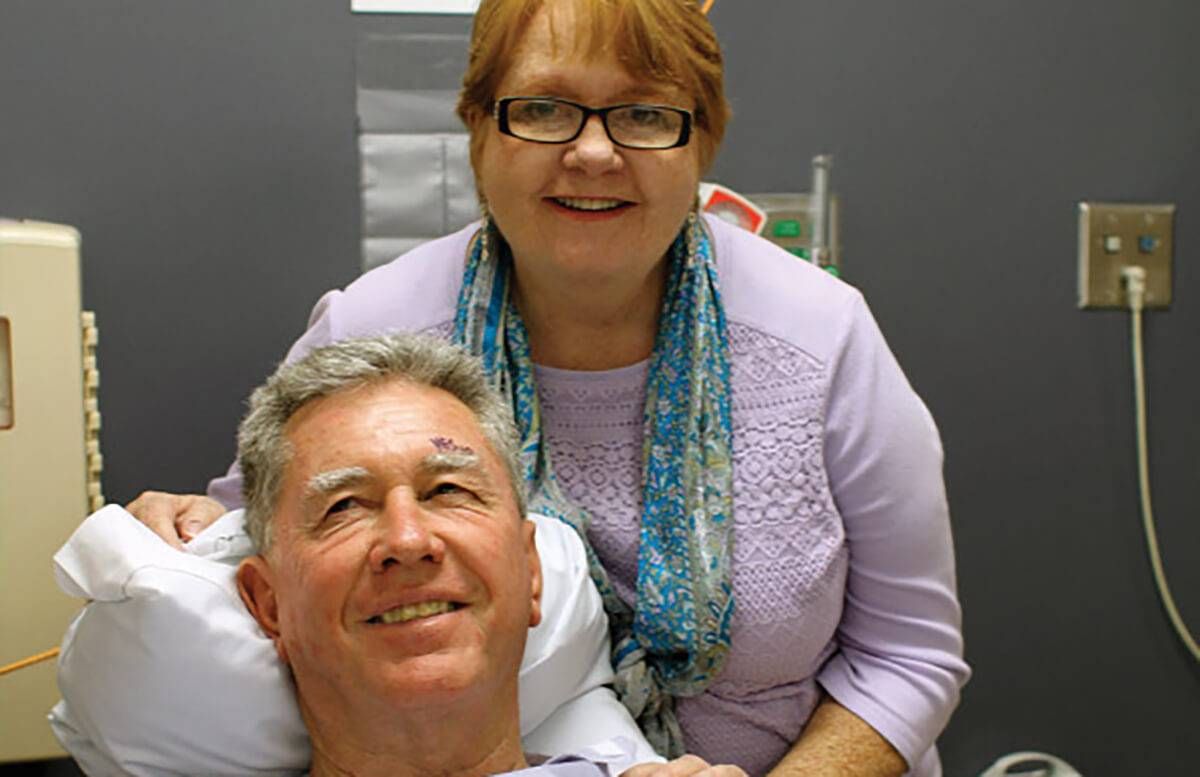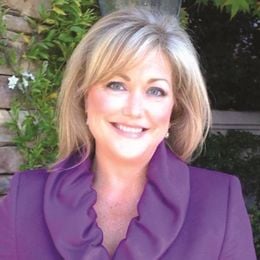How Caring for Her Blind Husband Challenged Their Marriage
The challenges of blindness are explored in this new PBS documentary
Many caregiving stories entail an adult daughter or son caring for a parent with Alzheimer’s disease, cancer or other age-related health issue. This caregiving story is different. It is about a devastating diagnosis — blindness — that could have destroyed a marriage but instead has a happily-ever-after ending.

I recently spent the day with Terry and Sue Byland. They were being interviewed for special social media outreach for an hour-long documentary premiering on PBS stations this week, Sight: The Story of Vision (check local listings here). The program is narrated by Sir Elton John. (The Bylands are not in the documentary itself.)
While the Bylands appear to be any ordinary couple who recently celebrated 30 years of marriage, Sue Byland told me about her extraordinary journey into her husband’s world of darkness and how they both found the light again.
Early Signs
When the couple met in the mid-1980s, Terry Byland was a divorced father of four young children, a tall, athletic, superhero kind of man. As their courtship headed toward marriage, Byland experienced increasing night blindness, especially while driving.
Sue Byland encouraged him to see an eye doctor. It was only a few weeks after they returned from their honeymoon that it became clear: The Bylands’ lives were going to take a different turn than either of them expected.
The ophthalmologist diagnosed Terry Byland with retinitis pigmentosa (RP), a rare genetic eye disease affecting one in every 4,000 people that can result in legal or complete blindness by age 40 or older.
Over the next seven years, Byland’s sight continued to diminish until he became completely blind at age 44. During this time, he had continued to work and the couple had a son, Daniel. But in 1993, Byland had to leave his job and rely on his wife for the everyday activities of life.
His Blindness Created Challenges for Both of Them
Sue Byland, who continued to work to support her family, explained both her concerns for her husband’s psychological health and her frustrations with a world that still does not seem to completely embrace those without sight.
Her biggest challenge was the impact losing his sight had on Byland’s self-esteem. In addition to no longer working, everything that came easily before was lost — such as playing on his beloved softball and baseball teams. He could no longer enjoy their Friday night movie date (he kept having to ask his wife what was happening during the films). As Terry Byland spiraled into depression, Sue Byland was struggling to keep it all together.
As Terry explained, “I wasn’t a very pleasant person to be around.”
His wife smiled at this. She said that initially she allowed her feelings to take a back seat to his during those dark days. Eventually, Sue realized that something had to change: She was working full-time, caring for a young son and also doing full-time caregiving for her husband.
‘A New Normal’
She knew there was only one way her husband would recover and she would get a break. They would have to create a new normal for this vibrant, active man who felt down for the count and was not getting up off the mat.
“He would say to me that I had no idea what it was like to be a blind person,” Sue says. She finally told him, “Well, you don’t know what it’s like to be married to and care for a person who is blind.”
Feeling frustrated, desolate and helpless, Terry offered his wife an exit strategy. “I told her, ‘You didn’t sign up for this and I’ll understand if you want to leave,' he says.”
There was emotion in both of their voices and their eyes as they retold the story to me and the filmmakers. Sue told us she quickly replied, “In my wedding vows I said in sickness and in health, for better or worse, and I meant it.”
As many caregivers find, hope comes by becoming an advocate for their loved one and seeking as much information as possible. Sue took to the computer to research as much as she could about her husband’s condition.
New Research
She came across a clinical trial for those with RP at the USC Roski Eye Institute. The trial was for a retinal implant system called the Argus, also known as “the bionic eye,” co-created by Dr. Mark Humayun, who is both an ophthalmologist and biomedical engineer.
As a young medical student who watched his beloved grandmother go blind due to diabetes, Humayun, who is interviewed in the documentary, helped pioneer the Argus system. It consists of an eyeglass-mounted camera and an electrode retinal stimulator. The stimulator, implanted on the eye, relays signals from the external camera to the retina which are passed to the brain via the optic nerve and interpreted as images.
Sue realized this could be the chance her husband needed. The procedure does not restore sight fully. Rather, the patient sees points of light that help the blind distinguish shapes and objects through contrast of dark and light. But the change is significant enough to allow those with RP to become more mobile and independent.
Terry had the implant in one eye in 2004.
“It is easier for a blind person who had sight and lost it to relearn to see using the Argus implant than a person who is blind from birth and has never seen,” explains Humayun, who received the National Medal of Technology and Innovation, the nation’s highest honor for technological achievement, from President Obama at a White House ceremony this spring.
“Terry has been an inspiration and an important part of our research team — he provides valuable feedback for improving the device and has become our unofficial ambassador for other patients considering the Argus,” Humayun said.
Gaining Independence
The Argus allowed Byland to navigate his home and feel secure enough to venture outside alone. Instead of his wife transporting him everywhere, he began taking the bus to the Braille Institute and rediscovering ways to be self-reliant again.
Still, he was hungry for more. The Bylands kept in constant contact with Humayun, who had promised them he was continuing to improve and refine his Argus creation.
Last year, Terry became the only man in the world to have his second eye implanted with the Argus II, the first FDA-approved retina prosthesis and second generation of the device. It offers three times the electrodes of the original to create even more pixels and clearer patterns. The Bylands have been amazed at how much more Terry can now see.
Prevalence of Blindness Rising Sharply
In an analysis published in May’s issue of JAMA Ophthalmology, researchers estimated visual impairment and blindness in the U.S. will double by 2050, much of it driven by an aging baby boom population facing eye issues such as age-related macular degeneration (AMD), glaucoma, diabetic retinopathy (DR) and cataracts.
According to study author Dr. Rohit Varma, who serves as director of the USC Roski Eye Institute and appears in the Sight documentary, “This study gives us a glimpse into the nation’s future eye health and it is cause for concern because many blinding eye diseases can be treated and some even prevented.”
The key is getting a regular eye exam — something many of those 50 and older ignore. The Mayo Clinic recommends that people age 40 to 54 get checked every two to four years, and older individuals should go as often as yearly.
“The earlier we can diagnose these blinding eye diseases, the more people will have the chance to live longer lives without physical limitations and the emotional impact of vision loss and blindness,” Varma concluded.
Helping Others
When Terry was diagnosed, his peripheral vision started narrowing, creating a tunnel that was getting smaller and smaller. As his sight disappeared in that tunnel, his wife worried whether either of them would see the light at the end of the tunnel again — literally and figuratively.
But, through her tough love, support, advocacy for her husband — and a device they both call a “miracle” — Sue has seen her strong husband become a superhero again.
She proudly told me that her husband visits the Braille Club in their local community to help others adjust and adapt as he has. She also believes his blindness and journey to hope made him see others’ challenges in a new way.
Terry now volunteers for the United Way and is a telephone counselor for a crisis hotline. He uses his strong but soothing voice to help those who are contemplating suicide, who have been victims of rape or abuse or who are encountering other difficult situations. He knows what it takes to survive.
Getting Through It Together
However, he gives most of the credit of his survival to his wife. Without her, he said, he would have given up.
For Sue, it was her career that helped her cope. As hard as it was to juggle all her responsibilities, she says, her job allowed (and still allows) her to focus on things other than her husband’s disability. Another secret ingredient to successful caregiving, according to Sue: communication.
“Talking with your loved one is key,” she says. “Don’t allow a breakdown in the communication and don’t hold back your fears and frustrations.” She believes that hiding her feelings from her husband at the onset of his blindness allowed him to retreat into a world where only his feelings mattered. Terry admits he had not given much thought to the impact of his blindness on his wife until she explained it to him.
Or as Sue puts it: “His life did not change; our lives changed.”
She also says humor helps soften the harsh reality of their lives, allowing her to come out of the tunnel and into the light again.
“Being able to laugh at the situation made us a team; it kept us both humble and connected about what we were facing,” she says.
Watch a video of the Bylands from the USC Roski Eye Institute below.

Sherri Snelling is a corporate gerontologist, speaker, and consultant in aging and caregiving. She is the author of “Me Time Monday – The Weekly Wellness Plan to Find Balance and Joy for a Busy Life” and host of the "Caregiving Club On Air" podcast. Read More

